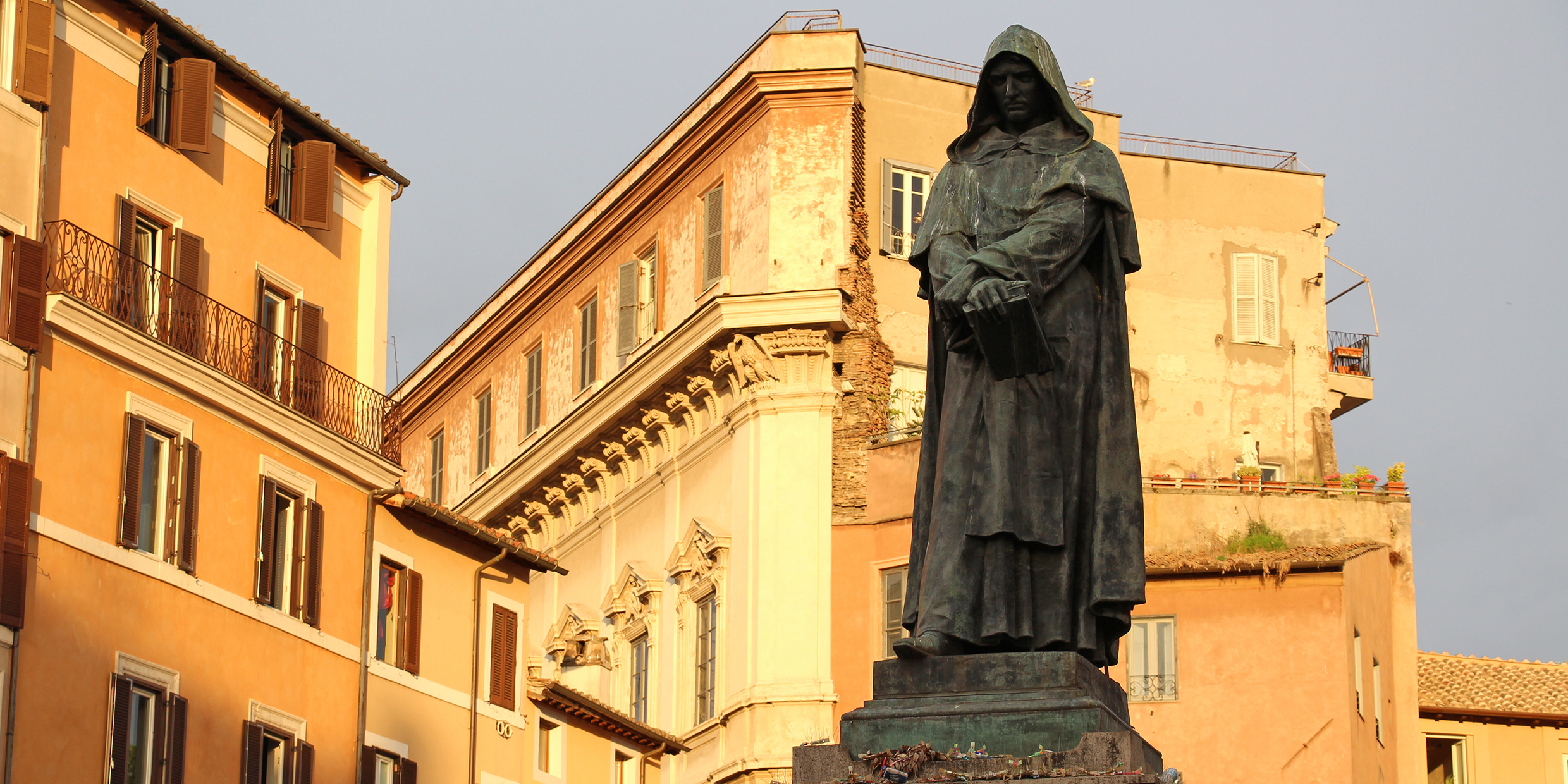Originally published 22 February 2000
Giordano Bruno was born in the Kingdom of Naples in 1548, only a few years after the death of Copernicus. At the age of 24 he was ordained a Dominican priest, although his curious and uninhibited mind had already attracted the disapproval of his teachers. Within a few years of ordination, he was accused of heresy — a first that would later occur many times. The very idea of heresy meant nothing to Bruno; he claimed for himself (and for others) the libertes philosophica, the right to philosophize, to dream, unfettered by authority or tradition.
Poet, philosopher, loose cannon: Bruno wandered across Europe all his life — Italy, Geneva, France, England, Germany — stirring up a fuss wherever he went, offending Catholics and Protestants alike, shaking up preconceptions, rattling complacencies, asking philosophers and shopkeepers to entertain a doubt or two: The universe and God might be bigger than we think.
He was a modern in many qualities of mind — materialist, rationalist, a champion of free and skeptical inquiry. The universe is a unity, he believed. He made no distinction between matter and spirit, body and soul, yet he was energized and exhilarated by the majesty of the universe as it was being revealed to the Renaissance successors of Copernicus. Among his more audacious dreams was of an infinitude of inhabited worlds — an idea that troubled the sleep of many a theologian.
The problem, within Christian theology, had to do with the supposed uniqueness of Adam’s fall into sin, and of the redemption of Christ. If there are other sentient beings in the universe, did they share in Adam’s sin, and did they require separate acts of atonement on the part of the Redeemer? It may seem strange to many of us, but these questions exercised theologians from Origen in the third century to Karl Rahner in the 20th.
In an article last year in the journal, Theological Studies, the Dominican theologian Thomas O’Meara surveys the long debate about the theological implications of multiple inhabited worlds, and comes to the conclusion that in these matters the Christian theologian should take a cosmic view and be guided by the discoveries of empirical science. An echo, it would seem, of Bruno.
In 1591, at the request of a potential patron, Bruno returned to Italy, to the Republic of Venice, perhaps because he was homesick, perhaps because he sought the Chair of Mathematics at the University of Padua, which he knew to be open. Big mistake. He was soon denounced by his erstwhile patron to the Inquisition. Extradited to Rome, he languished in a prison of the Holy Office for seven years, struggling to accommodate his tormenters without forsaking his principles.
Accommodation proved impossible. In February of 1600, he was taken gagged to the Campo de’ Fiori, or “Field of Flowers,” and put to the stake. Years ago, during a visit to Rome, I made my way to the Campo de’ Fiori, now a busy market square in the center of the city, to see the place where Bruno was burned. A melancholy and somewhat sinister statue of the philosopher stands on a pedestal in the square, erected by secular humanists in the 19th century when the unification of Italy liberated Rome from direct papal rule.
Bruno was not a scientist in the mold of Copernicus or Kepler. He was a dreamer who let the scientific search for truth inform his dreams. His vision of an infinitude of inhabited worlds was not based on any solid evidence, only on an intuition of what seemed in keeping with a Copernican cosmology. Within a decade of his execution, however, his dream took substance.
The vacant Chair of Mathematics at the University of Padua was offered to Galileo Galilee of Florence. In the winter of 1610, Galileo turned the world’s first astronomical telescope to the night sky and saw such things as would change the world forever — mountains on the Moon, the moons of Jupiter, the phases of Venus, spots on the Sun, and myriad tiny stars that twinkled beyond the limits of the human eye. He communicated these discoveries to the world in a book called The Starry Messenger, in which he claimed that the universe might be infinite and contain an infinitude of stars. Prudently, Galileo did not mention Bruno, although surely he knew of the radical philosopher and his unfortunate fate.
Today, we know that the universe might indeed be infinite, and certainly contains an uncountable number of suns; the Hubble Space Telescope looks out into a cosmos containing tens of billions of visible galaxies. With manned and unmanned craft, we have visited other worlds in our solar system, and we have discovered planets around other stars. Day and night we listen with radio telescopes for intelligible signals from other worlds, the discovery of which will be the only way we will ever know for sure whether or not we are alone.
What would Bruno have made of these modern discoveries? Certainly he would have applauded the questing spirit and independence of mind that guides astronomers and space engineers into the heavens, never knowing what to expect, open to any possibility. To do philosophy, one must first put everything to doubt, urged Bruno, and the modern scientist agrees. Above all else, we have learned that the only reliable guide to what is, is to open our eyes and see.



